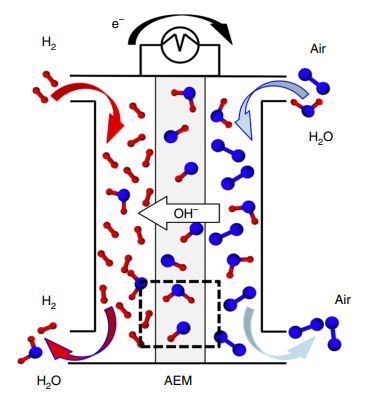Fabrizia Foglia, Quentin Berrod, Adam J. Clancy, Keenan Smith, Gérard Gebel, Victoria García Sakai, Markus Appel, Jean-Marc Zanotti, Madhusudan Tyagi, Najet Mahmoudi, Thomas S. Miller, John R. Varcoe, Arun Prakash Periasamy, Daniel J. L. Brett, Paul R. Shearing, Sandrine Lyonnard and Paul F. McMillan, Nature Materials 21 (2022) 555.
Semipermeable polymeric anion exchange membranes are essential for separation, filtration and energy conversion technologies including reverse electrodialysis systems that produce energy from salinity gradients, fuel cells to generate electrical power from the electrochemical reaction between hydrogen and oxygen, and water electrolyser systems that provide H2 fuel. Anion exchange membrane fuel cells and anion exchange membrane water electrolysers rely on the membrane to transport OH− ions between the cathode and anode in a process that involves cooperative interactions with H2O molecules and polymer dynamics. Understanding and controlling the interactions between the relaxation and diffusional processes pose a main scientific and critical membrane design challenge. Here quasi-elastic neutron scattering is applied over a wide range of timescales (100–103 ps) to disentangle the water, polymer relaxation and OH− diffusional dynamics in commercially available anion exchange membranes (Fumatech FAD-55) designed for selective anion transport across different technology platforms, using the concept of serial decoupling of relaxation and diffusional processes to analyse the data. Preliminary data are also reported for a laboratory-prepared anion exchange membrane especially designed for fuel cell applications.



